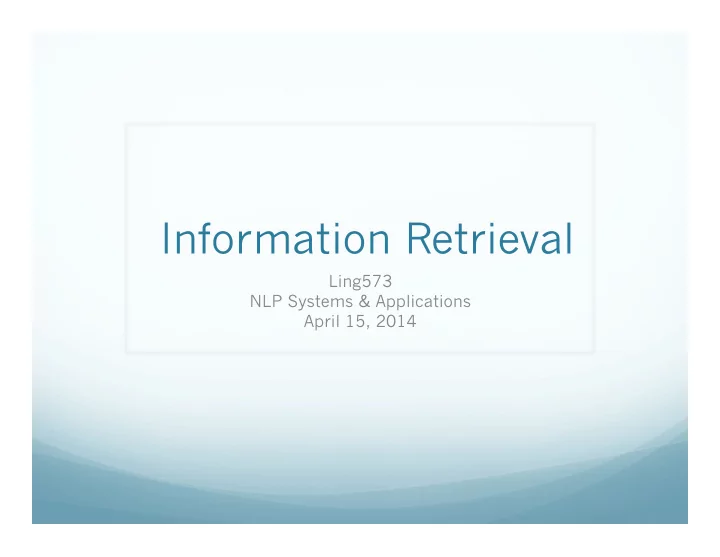

Information Retrieval Ling573 NLP Systems & Applications April 15, 2014
Roadmap Information Retrieval Vector Space Model Term Selection & Weighting Evaluation Refinements: Query Expansion Resource-based Retrieval-based Refinements: Passage Retrieval Passage reranking
Matching Topics and Documents Two main perspectives: Pre-defined, fixed, finite topics: “ Text Classification ” Arbitrary topics, typically defined by statement of information need (aka query) “ Information Retrieval ” Ad-hoc retrieval
Information Retrieval Components Document collection: Used to satisfy user requests, collection of: Documents: Basic unit available for retrieval Typically: Newspaper story, encyclopedia entry Alternatively: paragraphs, sentences; web page, site Query: Specification of information need Terms: Minimal units for query/document Words, or phrases
Information Retrieval Architecture
Vector Space Model Basic representation: Document and query semantics defined by their terms Typically ignore any syntax Bag-of-words (or Bag-of-terms) Dog bites man == Man bites dog Represent documents and queries as Vectors of term-based features d j = ( w 1, j , w 2, j ,..., w N , j ); E.g. q k = ( w 1, k , w 2, k ,..., w N , k ) N: # of terms in vocabulary of collection: Problem?
Representation Solution 1: Binary features: w=1 if term present, 0 otherwise Similarity: Number of terms in common Dot product sim ( N ∑ q k , d j ) = w i , k w i , j i = 1 Issues?
VSM Weights What should the weights be? “ Aboutness ” To what degree is this term what document is about? Within document measure Term frequency (tf): # occurrences of t in doc j Examples: Terms: chicken, fried, oil, pepper D1: fried chicken recipe: (8, 2, 7,4) D2: poached chick recipe: (6, 0, 0, 0) Q: fried chicken: (1, 1, 0, 0)
Vector Space Model (II) Documents & queries: Document collection: term-by-document matrix View as vector in multidimensional space Nearby vectors are related Normalize for vector length
Vector Space Model
Vector Similarity Computation Normalization: Improve over dot product Capture weights Compensate for document length Cosine similarity N ∑ w i , k w i , j sim ( q k , d j ) = i = 1 N N ∑ 2 ∑ 2 w i , k w i , j i = 1 i = 1 Identical vectors:
Vector Similarity Computation Normalization: Improve over dot product Capture weights Compensate for document length Cosine similarity N ∑ w i , k w i , j sim ( q k , d j ) = i = 1 N N ∑ 2 ∑ 2 w i , k w i , j i = 1 i = 1 Identical vectors: 1 No overlap: 0
Term Weighting Redux “ Aboutness ” Term frequency (tf): # occurrences of t in doc j Chicken: 6; Fried: 1 vs Chicken: 1; Fried: 6 Question: what about ‘Representative’ vs ‘Giffords’? “ Specificity ” How surprised are you to see this term? Collection frequency Inverse document frequency (idf): N w i , j = tf i , j × idf i idf = log( ) i n i
Tf-idf Similarity Variants of tf-idf prevalent in most VSM ∑ tf w , q tf w , d ( idf w ) 2 → → w ∈ q , d sim ( q , d ) = ∑ ( tf q i , q idf q i ) 2 ∑ ( tf d i , d idf d i ) 2 q i ∈ q d i ∈ d
Term Selection Selection: Some terms are truly useless Too frequent: Appear in most documents Little/no semantic content Function words E.g. the, a, and,… Indexing inefficiency: Store in inverted index: For each term, identify documents where it appears ‘the’: every document is a candidate match Remove ‘stop words’ based on list Usually document-frequency based
Term Creation Too many surface forms for same concepts E.g. inflections of words: verb conjugations, plural Process, processing, processed Same concept, separated by inflection Stem terms: Treat all forms as same underlying E.g., ‘processing’ -> ‘process’; ‘Beijing’ -> ‘Beije’ Issues: Can be too aggressive AIDS, aids -> aid; stock, stocks, stockings -> stock
Evaluating IR Basic measures: Precision and Recall Relevance judgments: For a query, returned document is relevant or non-relevant Typically binary relevance: 0/1 T: returned documents; U: true relevant documents R: returned relevant documents N: returned non-relevant documents Pr ecision = R T ;Re call = R U
Evaluating IR Issue: Ranked retrieval Return top 1K documents: ‘best’ first 10 relevant documents returned: In first 10 positions? In last 10 positions? Score by precision and recall – which is better? Identical !!! Correspond to intuition? NO! Need rank-sensitive measures
Rank-specific P & R
Rank-specific P & R Precision rank : based on fraction of reldocs at rank Recall rank : similarly Note: Recall is non-decreasing; Precision varies Issue: too many numbers; no holistic view Typically, compute precision at 11 fixed levels of recall Interpolated precision: Int Pr ecision ( r ) = max i >= r Pr ecision ( i ) Can smooth variations in precision
Interpolated Precision
Comparing Systems Create graph of precision vs recall Averaged over queries Compare graphs
Mean Average Precision (MAP) Traverse ranked document list: Compute precision each time relevant doc found Average precision up to some fixed cutoff R r : set of relevant documents at or above r Precision(d) : precision at rank when doc d found 1 ∑ Pr ecision r ( d ) R r d ∈ R r Mean Average Precision: 0.6 Compute average of all queries of these averages Precision-oriented measure Single crisp measure: common TREC Ad-hoc
Recommend
More recommend